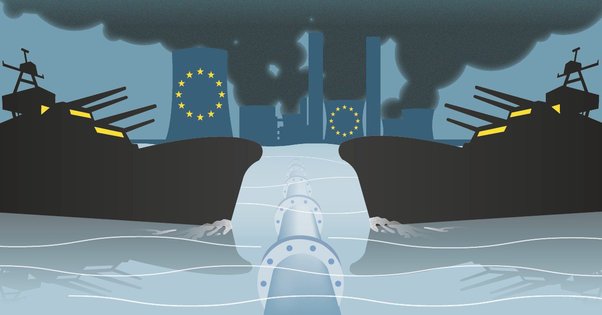
The EU’s imports of US liquefied gas are creating emissions that could cause more than €100 billion in damages from climate-driven extreme weather and disasters, new Global Witness analysis reveals
For the first time, the research calculates the cost of climate damages caused by emissions from EU imports of US liquified fossil gas – which contribute to climate-driven extreme weather such as heavier floods and stronger heatwaves – since the trade ramped up in 2022.
European Commission President Von der Leyen has suggested Europe could increase US gas imports to ward off the threat of heavier US tariffs on EU goods.
Brussels’ trade commissioner Maroš Šefčovič is also open to importing more US gas, stating that the US’s trade deficit – a key concern for President Trump – can be closed “very quickly through LNG purchases” and other imports such as farm produce.
The EU has imported 140 million tonnes of US liquified gas since 2022, according to the independent research firm Rystad Energy.
To calculate the €109 billion in global climate damages from the US-EU trade over this period, Global Witness investigators used the Biden administration’s social cost of carbon measure – USD$190 for every tonne of carbon emitted in 2020.
Global Witness Senior Campaigner Dominic Eagleton said:
“Governments are allowing big polluters to chain us to a fossil-fuelled future. The longer this goes on, the higher the cost to the public, from higher food prices driven by droughts, to catastrophic flooding and other extreme weather.
“The EU’s push to buy more US fossil gas is a bonanza for big polluters. Politicians in the European Union and beyond need to start properly taxing fossil fuel companies to pay for the climate damages they are inflicting on us all.”
Companies that have delivered, or signed contracts to supply, US liquified natural gas (LNG) to Europe include TotalEnergies, Shell and BP. Patrick Pouyanné, TotalEnergies’ CEO, recently called for the EU to loosen its LNG import regulations and negotiate an LNG free-trade deal with Trump.
Campaigners are calling for a tax on EU fossil fuel companies to help pay the costs of climate destruction. The floods in Valencia and from Storm Boris alone caused over €8 billion worth of damage in 2024, with the burden falling heavily on European taxpayers.
Meanwhile, European fossil fuel companies have no direct obligations to pay for the clean-up costs, despite making billions in profits from oil, gas and coal products that are most responsible for climate change-driven weather extremes.
The EU’s temporary windfall tax on fossil fuel profits raised €26 billion over 2022 and 2023, showing that a permanent EU-wide tax on the industry to fund climate action is viable.
Most if not all of the damage caused by emissions from Europe’s US LNG imports is unnecessary, campaigners say. Studies indicate that by strengthening its green energy policies, the EU could have quit Russian gas with only a minimal and temporary rise in LNG supply to maintain energy security, or without increasing LNG use at all.
Despite this, EU imports of US LNG alone more than doubled from 2021 to 2022, with contracted US volumes set to continue rising over the next decade even without a new US-EU deal, according to forecasts by Rystad Energy.
The US is the EU’s largest supplier of LNG, accounting for over 50% of imports in the first five months of 2025, and was the bloc’s third largest supplier of gas overall in 2024.
This raises concerns that Europe’s increasing reliance on US fuel is weakening its energy security, with Brussels facing a more hostile government in Washington that appears to be using LNG to fight a global trade war.
Global Witness’s analysis is based on an estimate of US LNG’s greenhouse gas emissions published by pro-LNG industry advocacy groups – 3.48 tonnes of CO2 equivalent for every tonne of LNG consumed in Europe.
The EU has imported 140 million tonnes of US LNG since Brussels announced a plan to boost supplies of US gas in March 2022, according to Rystad Energy.
To estimate the global climate damages cost of the US-EU trade over this period, we used a social cost of carbon measure used by the US government to inform policy decisions under the Biden administration – $190 for every tonne of carbon emitted in 2020.
The Trump administration has directed federal agencies to stop applying the social cost of carbon to policymaking, except when required by law.
Note to editors
Global Witness’s analysis is based on a detailed estimate of the lifecycle greenhouse gas emissions of US LNG, published by the LNG industry advocacy groups Natural Allies for a Clean Energy Future and the Partnership to Address Global Emissions (3.48 tonnes of CO2 equivalent per tonne of LNG).
The report estimates emissions for LNG produced with gas from the Marcellus Formation, exported from the US East Coast to France. It includes Scope 3 emissions from end use consumption, and a 100-year Global Warming Potential (GWP) factor for methane emissions.
LNG lifecycle emissions vary depending on multiple factors. For example, another study found that emissions from US LNG produced with gas from the Permian Basin, shipped from Texas to the UK, could reach 7.59 tonnes of CO2 equivalent per tonne of LNG, assuming a 20-year GWP factor for methane emissions.
Figures for EU import volumes of US LNG were taken from Rystad Energy’s LNG Trade Tracker – 140 million tonnes from April 2022 (after the US and EU agreed to increase trade volumes) to May 2025.
2.5% of the EU’s LNG imports were re-exported to non-EU destinations during the 2022-25 period, according to Rystad Energy. Because gas molecules from different countries are usually stored and mixed together after being imported to the EU, attributing LNG re-exports to their country of origin is difficult if not impossible. To find an approximation of and account for potential re-exports of US LNG, we assume that the share of US LNG in overall EU re-exports to non-EU countries is the same as the share of US LNG in overall EU LNG imports for each year during the 2022-25 period.
Excluding the approximation of US LNG re-exports, the EU imported 137 million tonnes of US LNG over the 2022-25 period.
To calculate the climate damage costs, we applied the US Environmental Protection Agency’s (US EPA) 2023 social cost of carbon estimate of $190 (2020 USD) per tonne of carbon dioxide emitted in 2020. Social cost of carbon values are used by governments around the world to inform cost benefit analysis in policy and investment decisions.
We followed the recommended methodology laid out by economists at the US EPA, multiplying emissions in each year by the corresponding social cost of carbon for that year, and using a 2% constant discount rate to compute the net present value of damages in the year of analysis (2025 using 2023 USD).
We used the average annual USD/EUR conversion rate of 0.93 during 2022-2025 to convert to EUR.


